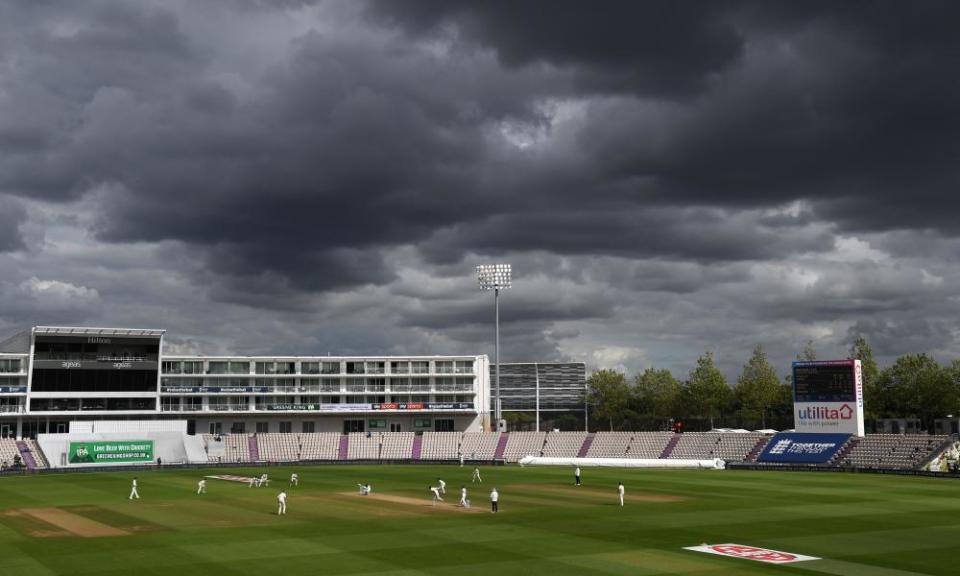World Test Championship is hard to love but final deserves more than a washout

The forecast is for rain. Of course the forecast is for rain. It’s the final of the World Test Championship on Friday: a concept first seriously mooted by Wisden a quarter of a century ago, first endorsed by the International Cricket Council in 2010, first organised for 2013 and then cancelled, then organised for 2017 and then cancelled again, whose first edition then ran into a global pandemic that detonated the entire qualification process and forced the showpiece final to be moved to a business hotel just off the B3035.
So naturally, as India and New Zealand prepare to meet at the Ageas Bowl, it is entirely appropriate the Met Office should offer a yellow warning for the Southampton area, predicting thunderstorms and “a small chance that homes and businesses could be flooded quickly”. In many ways, a washout in front of a sodden Covid-restricted crowd of 4,000 would be a fitting climax to the inaugural edition of the WTC: a competition that for all its best intentions and impressive logistical gymnastics has felt coldly cursed for pretty much its entire existence.
Related: World Test Championship a ‘real step forward’ for cricket, insists ICC
It is vaguely amusing to recall that the WTC was originally intended as Test cricket’s rapid response to the spectacular arrival of the Indian Premier League in 2008. From a marketing perspective, the lessons of the new franchise landscape appeared manifest. What do people want? A start and an end! The same teams playing each other on a regular basis! A league table! A proper final with a trophy and fireworks and a winner! When do they want it? Um … sometime in the next decade?
For most of the 2010s the ICC tried and mostly failed to get this giant balloon off the ground. If it wasn’t the endless scheduling problems, it was the apathy of their main broadcast partner, ESPN Star Sports, who squashed the first tournament in 2011 because there was no guarantee India would be involved. If it wasn’t the broadcasters, it was the intransigence and self-interest of the boards of India, Australia and England, who essentially killed the ICC’s second attempt at a WTC in 2014 as part of their odious “Big Three” takeover.
On current form, these two teams would probably might supply seven or eight players in a World XI
Even now, the competition has finally been winched into being, it seems to exist largely on lukewarm, begrudging sufferance. When the pandemic struck, the Board of Control for Cricket in India were quick to suggest shelving it indefinitely. Only last November, the incoming ICC chairman, Greg Barclay, declared that it was not “fit for purpose”. Virat Kohli dismissed it as a distraction a few months ago. Meanwhile, the zombie-like Champions Trophy is again to be quietly resurrected from 2025.
Certainly the WTC in its current guise feels like a hard thing to love: a weird misshapen platypus of a competition with its lop-sided format, its intractable points system before the pandemic where a tie in a two-match series was worth more points than a win in an Ashes Test, that England had to go to India but none of their closest rivals did. It is, in short, a mess. It is also – for all this – the best and only thing we have.

Because here’s the thing: for all the legitimate criticisms, the weird percentages, the baked-in unfairness, this blighted tournament has somehow spat out the best two teams in Test cricket. As much as aLord’s would have been the ideal setting, India v New Zealand a fine Southampton track has all the makings of a worthy final: a fixture that should test virtually all facets of the game and feature some of the modern game’s greatest practitioners.
For New Zealand, winning would be a fair shout as their greatest cricketing moment: greater than the Richard Hadlee-inspired win against a weak Australia in 1985-86, greater than their thrilling victory in the 2000 women’s World Cup final, greater even than the time Chris Martin smashed Harbhajan Singh over his head for four. More than that, it would be the ultimate endorsement of Kane Williamson’s brilliantly likable team and a meticulous ascent almost a decade in the making.
Related: Five things for England to fix before the Test series against India | Tanya Aldred
For India, victory would cement their status as Test cricket’s most complete side since the Australian team of the 2000s. They have dashers and grinders, orthodox batsmen and box office mavericks, world-class pace and world-class spin, household names and the first generation of working-class cricketers to have emerged from the IPL dream factory as fullyformed elite internationals. On current form, these two teams would probably supply seven or eight members of a Test world XI.
Here we are, then: the world’s most ruthlessly effective team against the world’s most ruthlessly efficient team. Above all, to have even reached this point in the headwind of a global pandemic, years of institutional apathy, decades of innate conservatism, is a monumental feat in its own right. In a way the struggle is one analogous to Test cricket: a game that is about doing the hard thing, putting in the hard yards, taking the road less travelled, often for little or theoretical reward.
We should probably be open about this: there is no promised land here, no finish line. Something will always be killing Test cricket and something will always be saving it. All we can really do is carry on fixing the roof, watching and caring, making sure the practitioners of cricket’s greatest format have decent crowds following them and good money for their trouble. And – for this week at least – praying for clear skies.

 Yahoo Finance
Yahoo Finance 